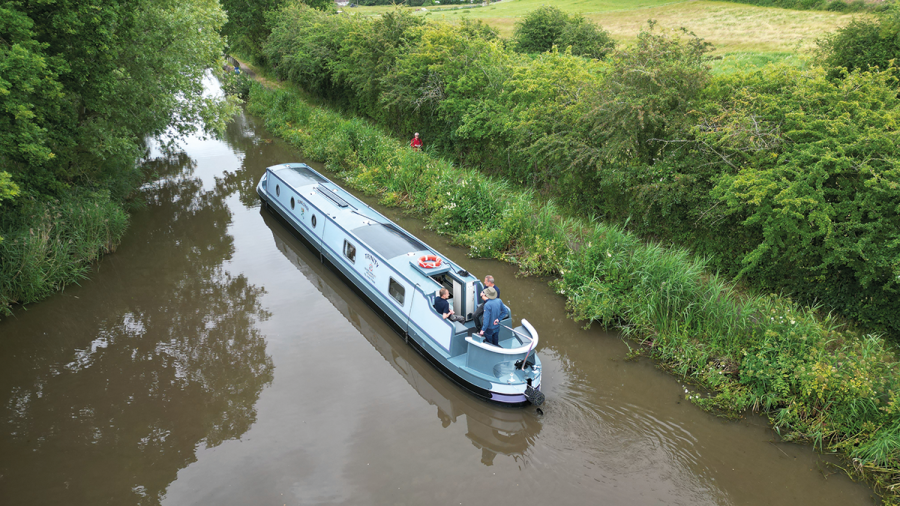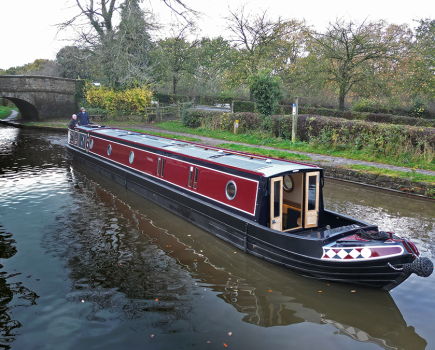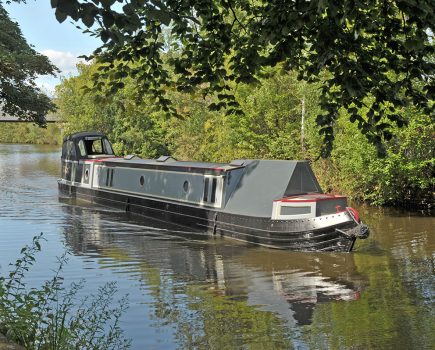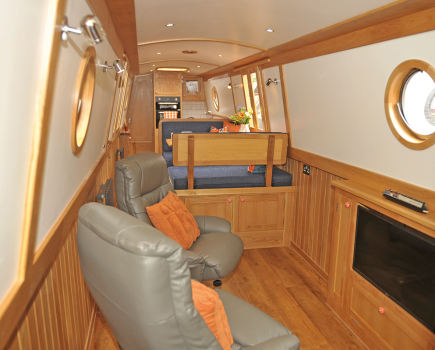We test an all-electric 62ft semi-cruiser hire boat.
Words by Adam Porters | Pictures by Andy Annable
There seems little doubt that the future of boating is electric. For a while now, we’ve tested more hybrid electric boats each year than pure diesel ones, and they were in the majority at the Crick Boat Show this year too.
But there’s also little doubt that having an electric boat gives you a few extra things to worry about. Many boaters are already obsessed with the state of their batteries, and it’s fair to say that when everything is electric you take that obsession to another level. And you can add obsessing about the amount of solar you’re generating, or how long you’re running your generator or engine for.
All of that possibly explains why electric hire boats are still a rarity. Will someone who’s taking a boat out for a week’s holiday want to think about state of charge? Will they reject a mooring near a pub because the trees will stop the sunlight getting to solar panels? These are the sort of questions that Dave Howdle and Phil Webster of Trinity boats asked themselves when they considered building an electric boat to add to their hire fleet. And despite the answers being more than a little uncertain, they decided to go ahead anyway! Sunflower is the result, and we were able to have a look at it just a few days before the first customers took it out on its maiden hire.
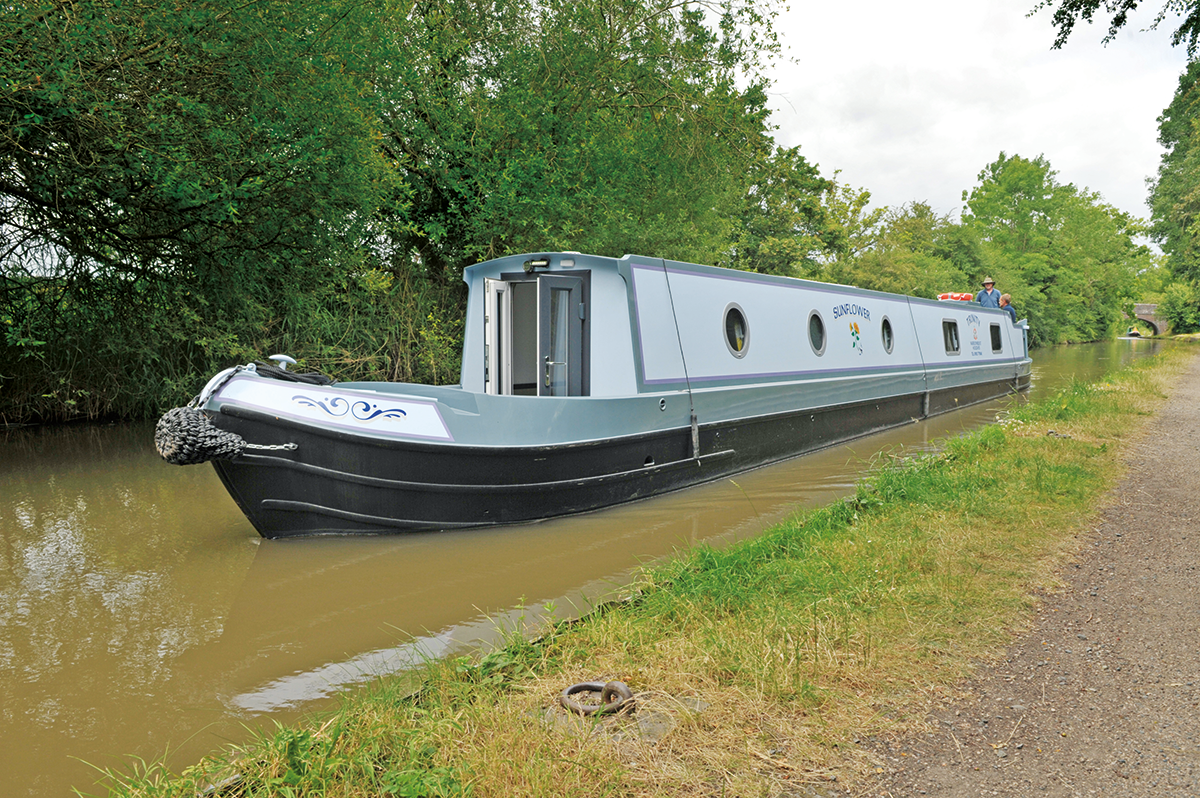
EXTERIOR
Sunflower is a 62ft boat, built on a lovely shell by Tim Tyler. As you’d expect from such a respected builder, the bow is a pleasing shape, and the lines are very elegant.
The well deck has lockers on three sides; the forward one gives access to the bow thruster, and the water filler is in one of the side ones. An anchor is provided in the other, given that the location of the Trinity hire base means that the boat is often likely to be on the River Severn. The lockers mean there’s plenty of seating in the well deck too.
The boat has a semi-cruiser stern, so there are lockers on both sides complete with cushions. There’s a Desmo socket set into the engine board, so a table can be erected outside. At the stern there’s a metal dodger round the back of the deck with a cutout at the very stern so it doesn’t look too heavy. There’s more seating with specially shaped cushions round the dodger. For safety reasons this wouldn’t be somewhere to sit while under way, but it means the back deck provides a very large social space when moored up.
There are two large solar panels on the roof, but there’s also room left for the plank and pole. The windows and portholes are by Caldwell’s, and are double glazed and have a thermal break to help stop condensation.
The boat shares its colour scheme with the other Trinity hire boats – pale grey panels with a darker border, and the nice addition of a purple coach line which just lifts the whole scheme. Apart from the Sunflower name, there are a couple of subtle indications that this is an electric boat: a painted sunflower has a plug on the end of its stem, and the three points in the Trinity logo are green rather than the usual blue.
LAYOUT AND FITOUT
This is a hire boat, so has two bedrooms in its 62ft length. It’s a reverse layout with the galley at the stern, which works very well with the semi-cruiser deck. Next comes the dinette and saloon, which can be used as a third sleeping area. The bedroom in the middle of the boat can be set up as a double or two singles, depending on the needs of the hirers. Next comes an off-corridor shower room, which works better that a walk-through on a boat which is likely to have at least four people on board. Finally, the cabin at the bow has a double bed.
The fitout is light, bright, and contemporary – using a combination of white and grey. There’s painted board routed to look like butt and bead below the gunwales; above is laminate in the galley, and in the rest of the boat a marine vinyl. This has a 3mm foam backing, which provides a bit of extra insulation, but is also UV stabilised, mildew and stain resistant, and fire retardant. It’s a material more often found in yachts. The bulkheads are laminate in a woodgrain effect, which adds some texture, and the same material is used to make the furniture, such as the bed bases. All the trim is painted dark grey, which contributes to the contemporary feel. The flooring is vinyl in the public areas and shower room, and carpet in the cabins.
GALLEY
Steps lead down from the stern deck into the galley, and there’s a radiator behind. There are cupboards either side, one of which is the electrical cupboard. The galley itself uses Howden’s units and doors in a soft grey, from their Greenwich range. The worktop is Corian, and has a composite sink and drainer; the tap has a filter, for drinking water. The units offer plenty of storage, and there’s even a very handy pull-out unit. There’s LED lighting under the worktop too, which will look great at night.
There’s no shortage of equipment on board. As this is a gas-free boat and has a big battery bank, everything is electric. So there’s an induction hob, and Indesit electric oven, and a slimline Indesit dishwasher (something that might come as a surprise in a hire boat). The fridge is a full size, 240-volt model by Fridgemaster, with an ice box.
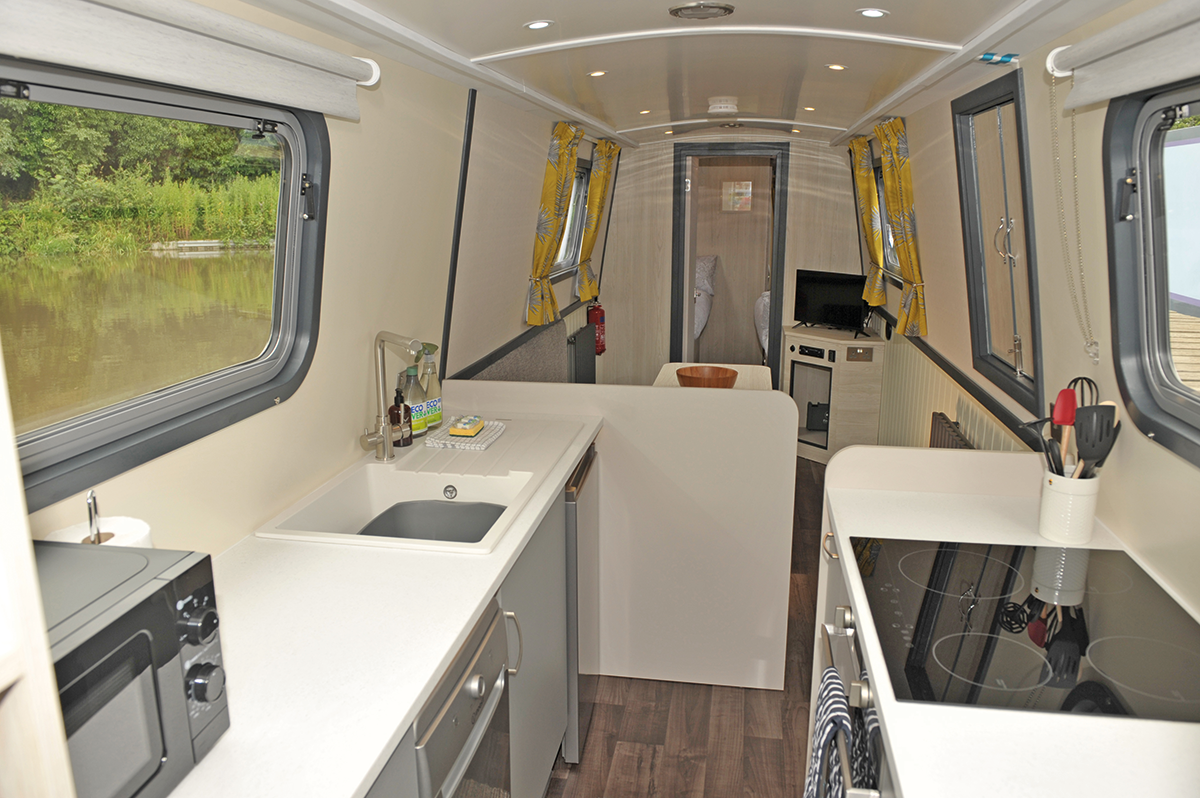
DINETTE/SALOON
This room has built-in L-shaped seating, around a removable table. It’s on Desmo legs, and there are short legs so the table can drop down, converting the dinette into an extra double bed.
A small corner unit carries a car radio, which has speakers built into the boat, and a smart tv making use of the boat’s Wi-Fi. There are classy grey column radiators, and the curtains are yellow and grey, giving a splash of colour.
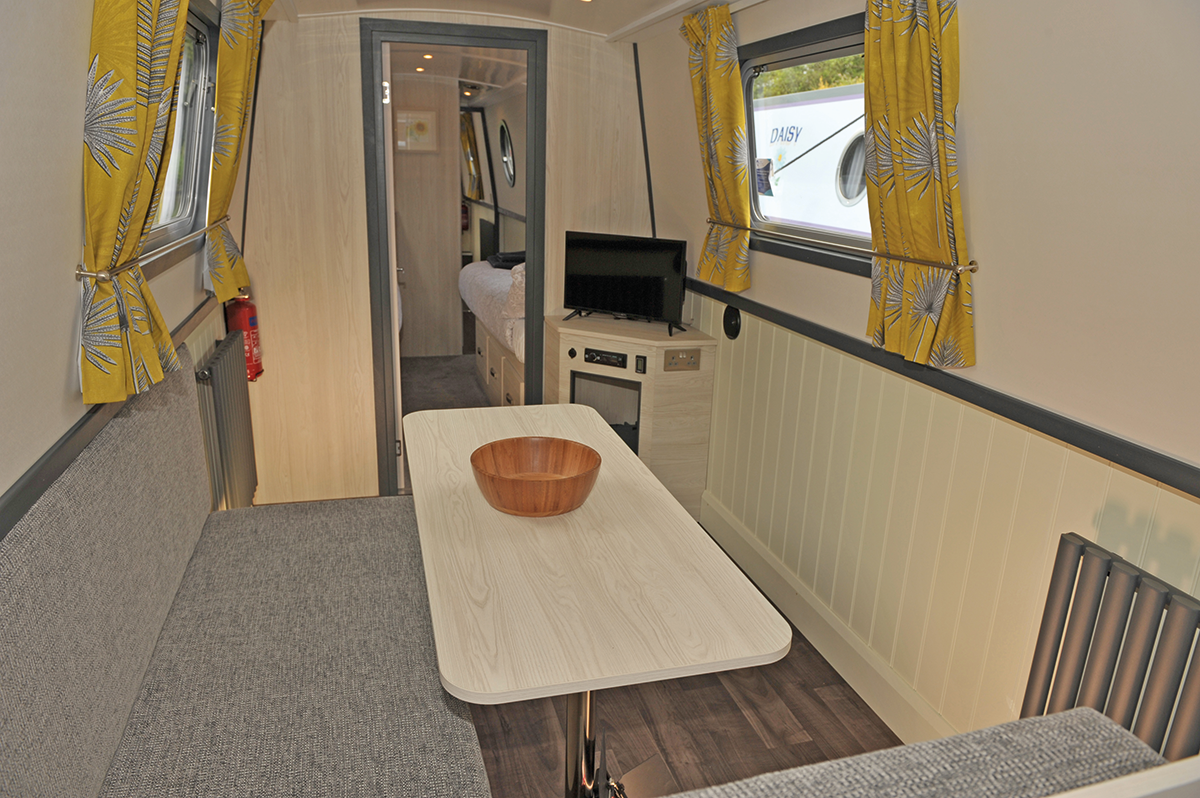
SECOND CABIN
This is a versatile space which can be set up to suit whoever is hiring that week. In one configuration there are two single beds on opposite sides of the room. Each has a reading light with a USB port for charging. But it’s also possible to make the beds into a double, as one base can be released and moved over to the other side. The drawers in the base come out and can be put in the other side, so no storage space is lost. Talking of storage, there’s a decent sized wardrobe with a hair-dryer inside.
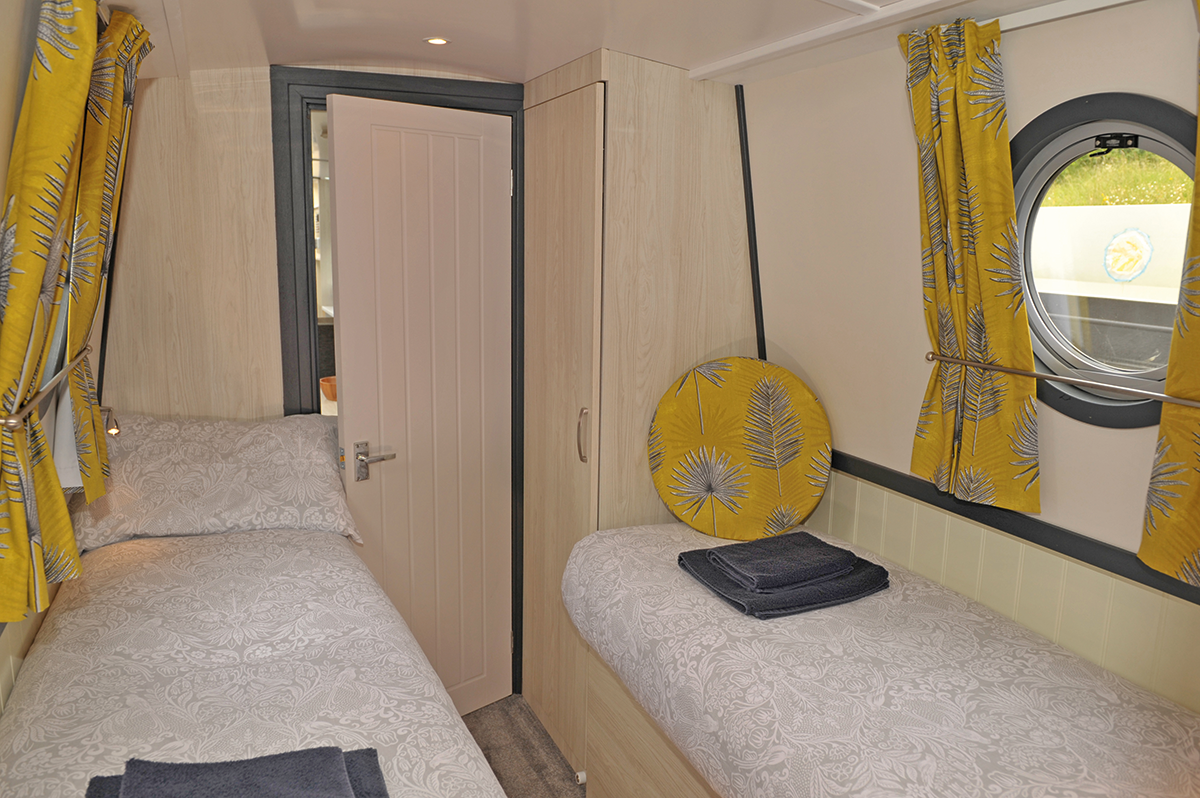
SHOWER ROOM
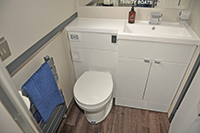 This is an off-corridor shower room, which makes the most sense in a boat like this. It means there’s always a route through the boat, even if someone is using the facilities.
This is an off-corridor shower room, which makes the most sense in a boat like this. It means there’s always a route through the boat, even if someone is using the facilities.
The shower cubicle is a generous 900x700mm, and has a laminate lining and smart fittings.
There’s a little bit of storage alongside. The loo is a macerating unit by Jabsco, with a holding tank under the bed behind. A unit carries a moulded basin, and the mirror behind carries the Trinity branding, just in case you forget who you’re hiring from! There’s a smart grey towel rail under the porthole.
CABIN
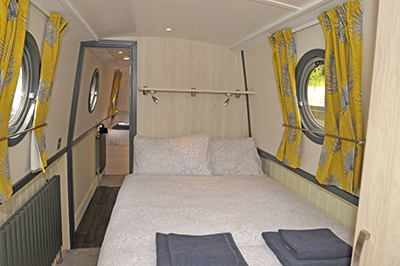 The main cabin, at the bow, has an inline bed, with reading lights and a shelf above the head. There’s a good sized wardrobe with both hanging and shelf space, and there’s more storage in the step up to the well deck. The big double doors onto the deck let in plenty of light. It’s a welcoming and comfortable space.
The main cabin, at the bow, has an inline bed, with reading lights and a shelf above the head. There’s a good sized wardrobe with both hanging and shelf space, and there’s more storage in the step up to the well deck. The big double doors onto the deck let in plenty of light. It’s a welcoming and comfortable space.
TECHNICAL
So far, this boat has delivered exactly what you’d expect from a newly-built hire boat: good quality accommodation that offers versatility and practicality. But electric drive is a real rarity among hire boats on the main system. (They are more common on the Monmouthshire & Brecon Canal, but that canal is equipped with charging points).
This boat has a serial hybrid system, meaning the prop is turned only by the electric motor, but there’s a generator for battery charging. Trinity have gone for a Beta system that they’ve used in boats they’ve built for private customers.
The electric motor is the Beta E-drive, delivering 14kw continuous power, and up to 25kw intermittently. It uses a belt to turn the prop, and is cooled by a water jacket. It comes with an LCD display so you can see how much power is being used, and joystick control.
The motor is teamed with a BetaGen10 generator to keep the batteries charged. It’s enclosed in a cocoon to keep the noise down. The batteries are a bank of six LiFePo4 lithiums, giving 600Ah at 48 volts. As well as the generator, they can be charged by shore power, and by the two huge semi-flexible solar panels on the roof. Each one is 500 watts, so there’s a full kilowatt up there. During the summer, it’s likely the solar array will be sufficient to make generator running a rarity rather than the norm.
There’s a 10kw Victron 48 inverter charger to give a 240-volt supply; it’s big, to help with the charging of the lithium batteries. A Victron converter system drops the 48 volt supply down to 12 volts for things such as the lighting circuit and the pumps.
A Victron Cerbo GX monitoring system has a display which shows what’s going on with the whole electrical system, including how much power is being used, and what’s being generated – but because a bit of knowledge is needed to understand everything, the display can be turned off when the boat is out on hire, so the customers don’t accidentally alter settings or turn things on or off. All the information is available on a smartphone app, so Dave Howdle back at base can see what’s going on.
The Cerbo system also manages the generator, so it’s programmed to come on automatically when the batteries drop to 60 per cent and go off again when they reach 90 per cent – except between 8pm and 8am – because neither hirers nor their mooring neighbours want to be woken up by a generator starting up. The generator will also come on if the motor is using more power than normal, for example if you were on a river and were going against the flow. The set up is designed to protect the batteries from ever getting too low, so whatever happens, you shouldn’t ever find yourself unexpectedly without battery power.
While the boat hadn’t been out with hirers when we saw it, Trinity’s Phil Webster and his wife went out for a few days on a test run, and decided to pay very little attention to what was going on with the batteries. He says they coped very well, they made the most of the solar, and the generator was rarely needed. Sunflower has a bow thruster to help with manoeuvring. It’s an electric one by Lewmar. Central heating comes from an Eberspacher boiler.
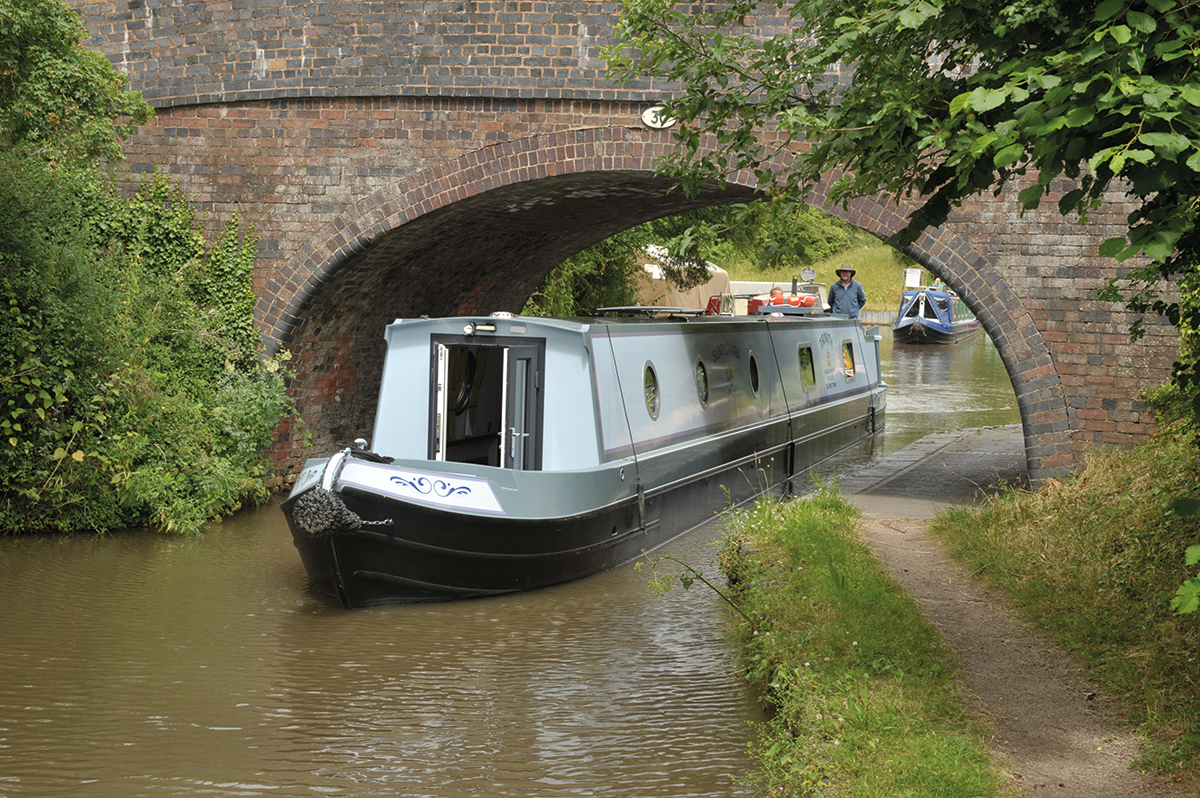
ON THE WATER
Quietness is one of the key benefits of electric drive, and this motor seemed particularly quiet; at normal canal speed there was very little to be heard, and I’m sure moored boats we passed wouldn’t have heard a thing. What you can hear is the water round the prop, birdsong, and everything anyone is saying from the towpath.
At the helm, the joystick control is easy to use, and the LCD display alongside shows how much power you’re using and the state of the batteries. You can start the generator manually from here too, if you think you need to.
The boat handles extremely well, as we’ve come to expect from a Tim Tyler shell. If you push the tiller over and put some power on, the bow moves round sharply without the aid of the bow thruster.
The large back deck is a very sociable space, with plenty of room for all the holiday makers on board to keep the helm company if they want to.
And if you’re wondering how the first hire customers got on, they loved the quietness and enjoyed all the mod cons. They did the Avon Ring in a week, and had no problems at all with the boat. The only problem, they said, was that they might now find a ‘normal’ hire boat a bit of a let down!
CONCLUSION
This is a boat which in one way is exactly what you thought it was, and in another way totally different. The fitout is bright and welcoming, and will undoubtedly make a good impression on hire customers. But the electric drive system is unusual in this market.
If you wanted a boat like this, Trinity say one would start at around £180,000 – which these days is a very good price for an electric drive boat. However, a hire boat fitout is necessarily a little simpler than a bespoke boat for a customer, so a private boat would almost certainly be a bit more.
In many ways, this boat is an experiment. If hirers like it and the system copes with them, then it’ll be a success. If it turns out that you really do need to obsess about battery charging and solar input, then Dave and Phil at Trinity are quite willing to think again. But progress is progress, and the hire boat industry won’t be able to stick to diesel forever. And if you’re in the market for an electric boat but have never driven one or lived with one, then it’s nice to know that the option is there to go and experience one for a week or two.
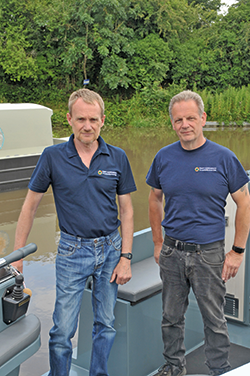 SPONSORED HIRE BOATS
SPONSORED HIRE BOATS
Many hire fleets have sponsored boats in their fleets, and Trinity is no exception – indeed Sunflower is a sponsored boat (actually it’s half sponsored, as Trinity and the sponsor owner went halves, given that it’s a bit of an experiment). The principle is simple: someone other than the hire fleet owns the boat, and gets some of the rental income; the hire fleet manage all the bookings, the turnarounds, and the maintenance. It’s a system which means hire fleets don’t have to come up with the capital for every new boat, while owners get income for a few years and can then have the boat for themselves if they want it.
The way the scheme works at Trinity is that they’ll build a boat at cost price. It then has to stay in the hire fleet for at least four years. During that time, the owner gets 35 per cent of the hire income, plus they get six weeks a year to use the boat themselves. At the end of the four years, the boat could stay in the fleet if the owner prefers, or it can be handed over to them, or sold.
Sunflower is Trinity’s fifth hire boat, operating out of the firm’s attractive little base at Dunhampstead Wharf near Droitwich. A shell which will become the sixth was there waiting to be fitted out when we visited, and Dave and Phil are hoping to add a seventh by the end of the year.
Specification
Length: 62ft
Beam: 6ft 10in
Shell: Tim Tyler www.timtylerboats.com
Style: Semi-cruiser
Layout: Reverse
Berths: 2+2+2
Fit-out: Painted panels, laminate
Electric motor: Beta E-Drive www.betamarine.co.uk
Generator: Beta Gen10 www.betamarine.co.uk
Bow thruster: Lewmar www.lewmar.com
Inverter: Victron 48 10kw www.victronenergy.com
CONTACT
Trinity Boats
Dunhampstead Wharf,
Droitwich
Worcestershire WR9 7JX
info@trinityboats.co.uk
www.trinityboats.co.uk
01905 779048
£180,000
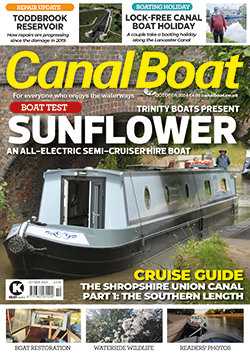 As featured in the October 2024 issue of Canal Boat. Buy the issue here
As featured in the October 2024 issue of Canal Boat. Buy the issue here

